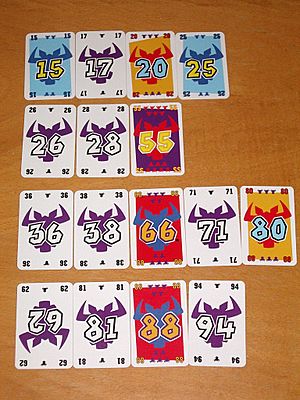6 Nimmt! facts for kids
| Designer(s) | Wolfgang Kramer |
|---|---|
| Illustrator(s) | Franz Vohwinkel |
| Publisher(s) | Amigo Spiele |
| Players | 2–10 |
| Setup time | ~5 minutes |
| Playing time | ~45 minutes |
| Age | 8+ |
6 Nimmt! / Take 6! is a fun card game for 2 to 10 players. It was created by Wolfgang Kramer in 1994 and published by Amigo Spiele. This game even won an award called the Deutscher Spiele Preis in 1994!
Contents
How to Play 6 Nimmt!
The game has 104 cards. Each card has a number and some bull's head symbols. These bull's heads are "penalty points" you want to avoid!
A game is played over several rounds. In each round, players play 10 cards from their hand. The cards are placed into four rows on the table. If you have to place a card on a row that already has five cards, you must take all five cards. These cards count as penalty points. The game ends when someone reaches 66 penalty points. The player with the fewest penalty points wins!
What's on the Cards?
The cards are numbered from 1 to 104. Each card gives a certain number of bull's head points if you pick it up.
Here's how many points each type of card gives:
- 7 bull's heads: Only card number 55.
- 5 bull's heads: Cards like 11, 22, 33, 44, 66, 77, 88, 99 (multiples of 11, except 55). There are 8 of these cards.
- 3 bull's heads: Cards like 10, 20, 30, 40, 50, 60, 70, 80, 90, 100 (multiples of ten). There are 10 of these cards.
- 2 bull's heads: Cards like 5, 15, 25, 35, 45, 65, 75, 85, 95 (multiples of five, but not ten, and not 55). There are 9 of these cards.
- 1 bull's head: All the other cards from 1 to 104. There are 76 of these cards.
Setting Up the Game
To start, each player gets 10 cards. Keep your cards secret from other players.
Then, four cards are placed face-up on the table. These cards start the four rows where players will place their cards.
Playing a Round
Each turn, everyone secretly chooses one card from their hand. When everyone has chosen, all players show their cards at the same time.
Now, players place their cards on the table, starting with the lowest numbered card. Here are the rules for placing a card:
- Rule 1: Your card must be placed on a row where the last card is a lower number than your card.
- Rule 2: Your card must go on the row where the last card is the closest number to your card. For example, if you play a 33, and there's a row ending in 30 and another ending in 29, you must place your 33 next to the 30 because it's closer.
- Rule 3: If you place your card on a row that already has 5 cards (meaning your card is the 6th card for that row), you must pick up all 5 cards already in that row. These cards are your penalty points! Your card then starts a new row. Keep your collected penalty cards separate from your hand.
- Rule 4: What if your card is lower than the last card in ALL four rows? Oh no! You must choose one of the four rows. You then pick up all the cards in that row (these are your penalty points!). Your card then starts a new row in that spot. Usually, you'll choose the row with the fewest bull's heads.
Players continue to choose and play cards for 10 turns until all cards from their hands are played.
Winning the Game
After 10 turns, each player counts the bull's heads on the cards they collected. This is their score for the round. Write down everyone's score.
The game continues with new rounds until one player reaches a total of 66 or more bull's heads. The player with the lowest total score (fewest bull's heads) wins the game!
Game Variations
There are a few different ways to play 6 Nimmt! to make it even more interesting:
Choosing Your Starting Cards
In this version, all the cards are placed face-up on the table. One player is chosen to start, and then players take turns picking one card at a time. This continues until everyone has 10 cards. The remaining 4 cards are used to start the rows on the table, just like in the regular game. The rest of the rules stay the same.
A Version for Younger Kids
This version is great for teaching younger children about numbers and counting.
- Each player gets 15 cards. The rest of the cards stay in a face-down deck.
- Five cards are placed face-up on the table to start the rows.
- Players take turns flipping over the top card from their own deck and placing it according to the usual rules.
- You play until all 15 cards are used.
- The winner is the one who has the most points! This version is mostly about luck, so kids and adults have an equal chance to win.
See also
 In Spanish: 6 nimmt! para niños
In Spanish: 6 nimmt! para niños


